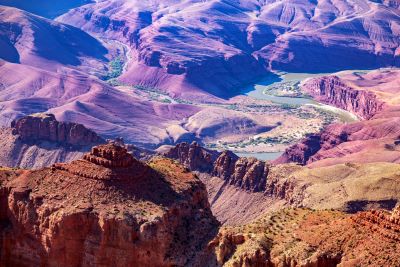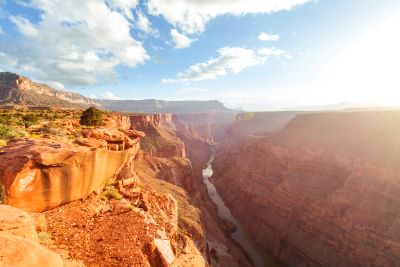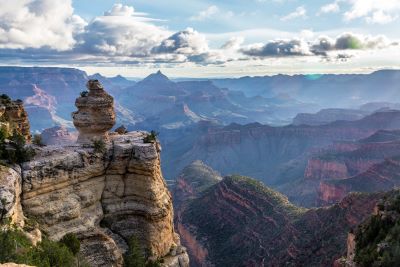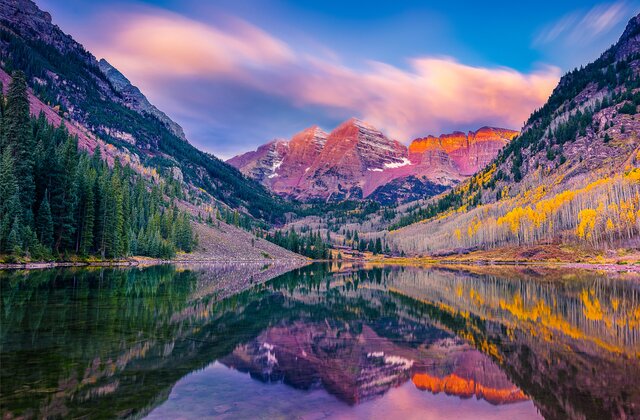
Discovering the Mysteries of the Grand Canyon: What You Never Knew
The Grand Canyon is a natural wonder that has captivated the imagination of people for centuries. Its geological history dates back millions of years, and the canyon itself is a testament to the power of erosion and the forces of nature. The formation of the Grand Canyon began over 6 million years ago, as the Colorado River carved its way through the rock layers of the Colorado Plateau. The layers of rock exposed in the canyon walls tell a story of ancient seas, volcanic eruptions, and tectonic activity. The oldest rocks in the canyon are nearly 2 billion years old, and they provide a glimpse into the Earth's distant past. Over time, the Colorado River continued to erode the rock, creating the vast chasm that we see today. The Grand Canyon is a living testament to the Earth's geological history, and it continues to inspire awe and wonder in all who visit.
The geological history of the Grand Canyon is a complex and fascinating story that has been studied by geologists for decades. The layers of rock in the canyon walls provide a record of ancient environments and climate change, and they offer valuable insights into the Earth's history. The canyon's unique geology has also played a crucial role in shaping the region's biodiversity, as different rock layers provide habitats for a wide variety of plant and animal species. The Grand Canyon is a living laboratory for geologists, and it continues to yield new discoveries and insights into the Earth's past. As our understanding of the canyon's geological history grows, so too does our appreciation for the forces that have shaped this natural wonder over millions of years.
The Native American Connection to the Grand Canyon
The Grand Canyon has been home to Native American tribes for thousands of years, and their connection to the land runs deep. For many tribes, the canyon is a sacred place that holds great spiritual significance. The Havasupai, Hualapai, Navajo, and Hopi are just a few of the tribes that have historical ties to the Grand Canyon, and each has its own unique traditions and stories about the canyon. For these tribes, the canyon is not just a natural wonder, but a place of great cultural importance. Many Native American tribes have lived in and around the Grand Canyon for generations, and their traditional knowledge of the land has been passed down through oral histories and cultural practices. The canyon is not only a physical landscape for these tribes, but also a spiritual one that is deeply intertwined with their identity and way of life.
The Native American connection to the Grand Canyon is an integral part of the region's history and culture. For centuries, Native American tribes have relied on the canyon for food, water, and shelter, and they have developed deep spiritual connections to the land. The canyon is home to numerous sacred sites and ceremonial areas that are still used by tribes today. Many Native American tribes also continue to practice traditional activities such as hunting, gathering, and storytelling in the canyon, keeping their cultural heritage alive. The Grand Canyon is not just a national park or tourist destination; it is a living landscape that holds great significance for the Native American tribes who call it home.
The Biodiversity of the Grand Canyon
The Grand Canyon is home to an incredible array of plant and animal species, making it one of the most biodiverse regions in North America. The canyon's unique geology and topography create a wide range of habitats, from desert scrublands to pine forests, which support a diverse array of life. The canyon is home to over 1,500 plant species, including rare and endemic species that are found nowhere else in the world. The diverse plant life in the canyon provides food and shelter for a wide variety of animal species, including mammals, birds, reptiles, and amphibians. The Grand Canyon is also home to several endangered species, such as the California condor and the humpback chub, which rely on the canyon's unique habitats for their survival.
The biodiversity of the Grand Canyon is a testament to the region's ecological richness and importance. The canyon's diverse habitats support a wide variety of plant and animal species, many of which are uniquely adapted to survive in this harsh environment. The canyon's biodiversity also plays a crucial role in maintaining ecosystem health and resilience, as different species interact with each other in complex ways. As our understanding of the canyon's biodiversity grows, so too does our appreciation for the interconnected web of life that exists within this natural wonder. Protecting the biodiversity of the Grand Canyon is crucial for maintaining the health and integrity of this unique ecosystem for future generations.
The Hidden Caves and Waterfalls of the Grand Canyon
The Grand Canyon is not only known for its breathtaking vistas and towering cliffs but also for its hidden caves and waterfalls that lie deep within its walls. These hidden features are often inaccessible to most visitors but are a testament to the power of erosion and the forces of nature that have shaped this landscape over millions of years. Some of these caves are formed by underground springs that have carved out intricate passageways through the rock layers, while others are formed by ancient lava flows that have created unique geological formations. Many of these caves are home to rare plant and animal species that have adapted to survive in these dark and isolated environments. Similarly, hidden waterfalls can be found throughout the canyon, cascading down its walls in remote locations that are only accessible to experienced hikers and adventurers.
The hidden caves and waterfalls of the Grand Canyon are a testament to the region's geological richness and complexity. These hidden features provide valuable insights into the forces that have shaped this landscape over millions of years and offer unique habitats for rare plant and animal species. Exploring these hidden caves and waterfalls requires careful planning and preparation, as they are often located in remote and rugged terrain. However, for those willing to make the journey, these hidden features offer a glimpse into a world that few have seen and provide a deeper understanding of the natural wonders that lie within the Grand Canyon.
The Mysterious Disappearances and Legends of the Grand Canyon
The Grand Canyon has long been shrouded in mystery and legend, with tales of mysterious disappearances and unexplained phenomena dating back centuries. Many Native American tribes have stories about supernatural beings that inhabit the canyon, such as shape-shifting spirits or powerful deities that control the forces of nature. Similarly, European explorers who first ventured into the canyon reported strange occurrences and unexplained events that fueled rumors of curses or otherworldly forces at play. Over time, these legends have become part of the fabric of the canyon's history, adding an air of mystery and intrigue to this already enigmatic landscape.
The mysterious disappearances and legends of the Grand Canyon continue to capture the imagination of people from around the world. While many of these stories may be rooted in folklore or superstition, they add an element of mystique to this already awe-inspiring landscape. Some visitors to the canyon have reported strange experiences or unexplained phenomena that they cannot easily explain, adding to the allure of this natural wonder. Whether these legends are based in fact or fiction, they serve as a reminder that there is still much about the Grand Canyon that remains unknown and unexplored.
The Impact of the Grand Canyon on Science and Research
The Grand Canyon has played a crucial role in shaping our understanding of geology, ecology, and natural history. Scientists from around the world have flocked to this natural wonder to study its unique geology, biodiversity, and ecological processes. The canyon's exposed rock layers provide a record of ancient environments and climate change, offering valuable insights into Earth's history. Similarly, its diverse habitats support a wide variety of plant and animal species that have been studied by ecologists for decades. The Grand Canyon has also been instrumental in shaping our understanding of how rivers shape landscapes over time, as well as how ecosystems respond to environmental change.
The impact of the Grand Canyon on science and research cannot be overstated. The canyon has been a living laboratory for scientists from a wide range of disciplines, providing valuable insights into Earth's history and natural processes. Research conducted in the canyon has led to numerous discoveries and breakthroughs that have advanced our understanding of geology, ecology, and environmental science. As our understanding of this natural wonder grows, so too does our appreciation for its importance as a scientific resource.
The Future of the Grand Canyon: Conservation and Preservation Efforts
The future of the Grand Canyon depends on our ability to conserve and protect this natural wonder for future generations. Over time, increased visitation and development have put pressure on this fragile ecosystem, threatening its biodiversity and ecological integrity. Conservation efforts are crucial for protecting this unique landscape from further degradation and ensuring that it remains a vibrant and healthy ecosystem for years to come. Efforts to reduce pollution, manage visitor impacts, and protect endangered species are all essential for preserving the Grand Canyon's natural beauty.
Conservation efforts are also crucial for protecting the cultural heritage of Native American tribes who call this region home. Many tribes have historical ties to the canyon that stretch back thousands of years, and their traditional knowledge and cultural practices are deeply intertwined with this landscape. Preserving their cultural heritage is essential for maintaining the integrity of this natural wonder and ensuring that it remains a place of great spiritual significance for future generations.
The Grand Canyon is a natural wonder that holds great significance for people from around the world. Its geological history dates back millions of years, providing valuable insights into Earth's past. The canyon is also home to numerous Native American tribes who have historical ties to this region that stretch back thousands of years. Its incredible biodiversity supports a wide variety of plant and animal species that have adapted to survive in this harsh environment. Hidden caves and waterfalls lie deep within its walls, adding an air of mystery and intrigue to this already enigmatic landscape. The impact of the Grand Canyon on science and research cannot be overstated; it has been instrumental in shaping our understanding of geology, ecology, and natural history. Conservation efforts are crucial for protecting this natural wonder from further degradation and ensuring that it remains a vibrant and healthy ecosystem for future generations.












